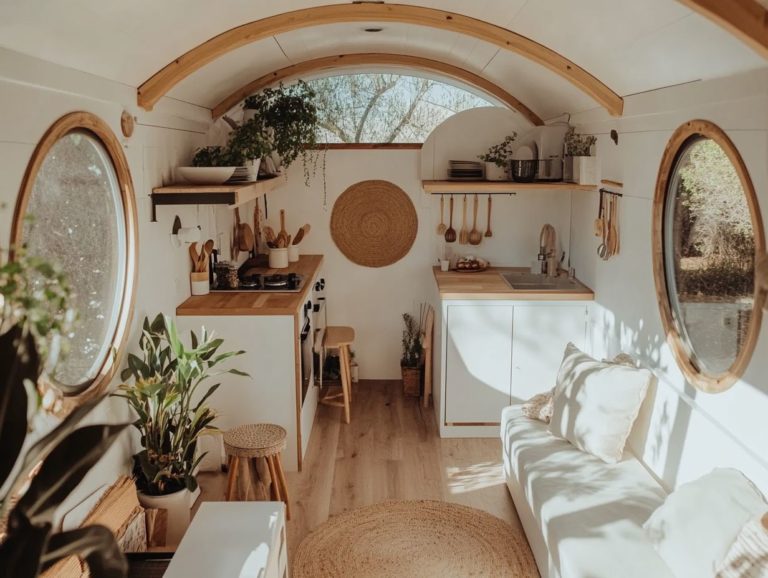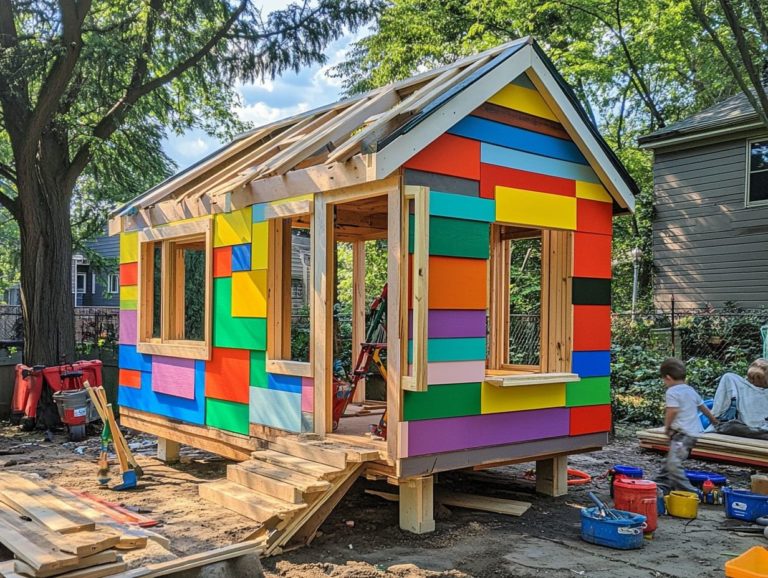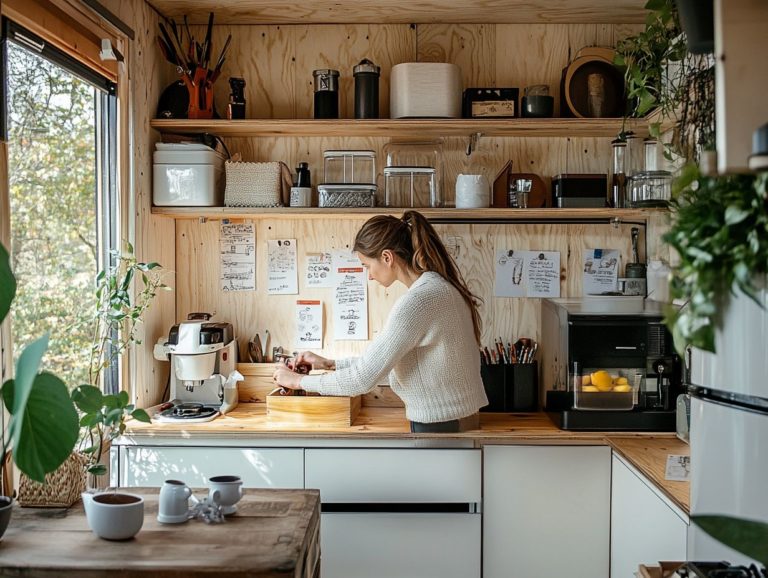Top 10 DIY Projects for Tiny House Enthusiasts
Embracing the tiny house lifestyle invites you into a realm brimming with creativity and resourcefulness.
Whether your aim is to optimize space, enhance sustainability, or add a personal flair, DIY projects stand as the ideal means to transform your compact living environment.
Discover ten innovative DIY projects specifically crafted for tiny house enthusiasts.
From constructing your own Murphy bed to designing a vertical herb garden, these tiny house ideas will maximize your space while infusing your home with charm and functionality.
Prepare to unleash your inner DIY aficionado!
Contents [hide]
- Key Takeaways:
- 1. Build Your Own Murphy Bed
- 2. Create a Vertical Herb Garden
- 3. Install a Composting Toilet
- 4. Make Your Own Solar Panels
- 5. Construct a Loft for Extra Space
- 6. Use Multipurpose Furniture
- 7. Install a Rainwater Collection System
- 8. Build a Tiny House on Wheels
- 9. Create a Fold-Down Table
- 10. Utilize Under Stair Storage
- What Are the Benefits of DIY Projects for Tiny Houses?
- Frequently Asked Questions
- What are the top 10 DIY projects for tiny house enthusiasts?
- Why are these DIY projects beneficial for tiny house enthusiasts?
- Do I need to be an experienced builder to complete these projects?
- Can I incorporate these projects into an already built tiny house?
- Are these projects cost-effective?
- How can I find more information about these projects?
Key Takeaways:
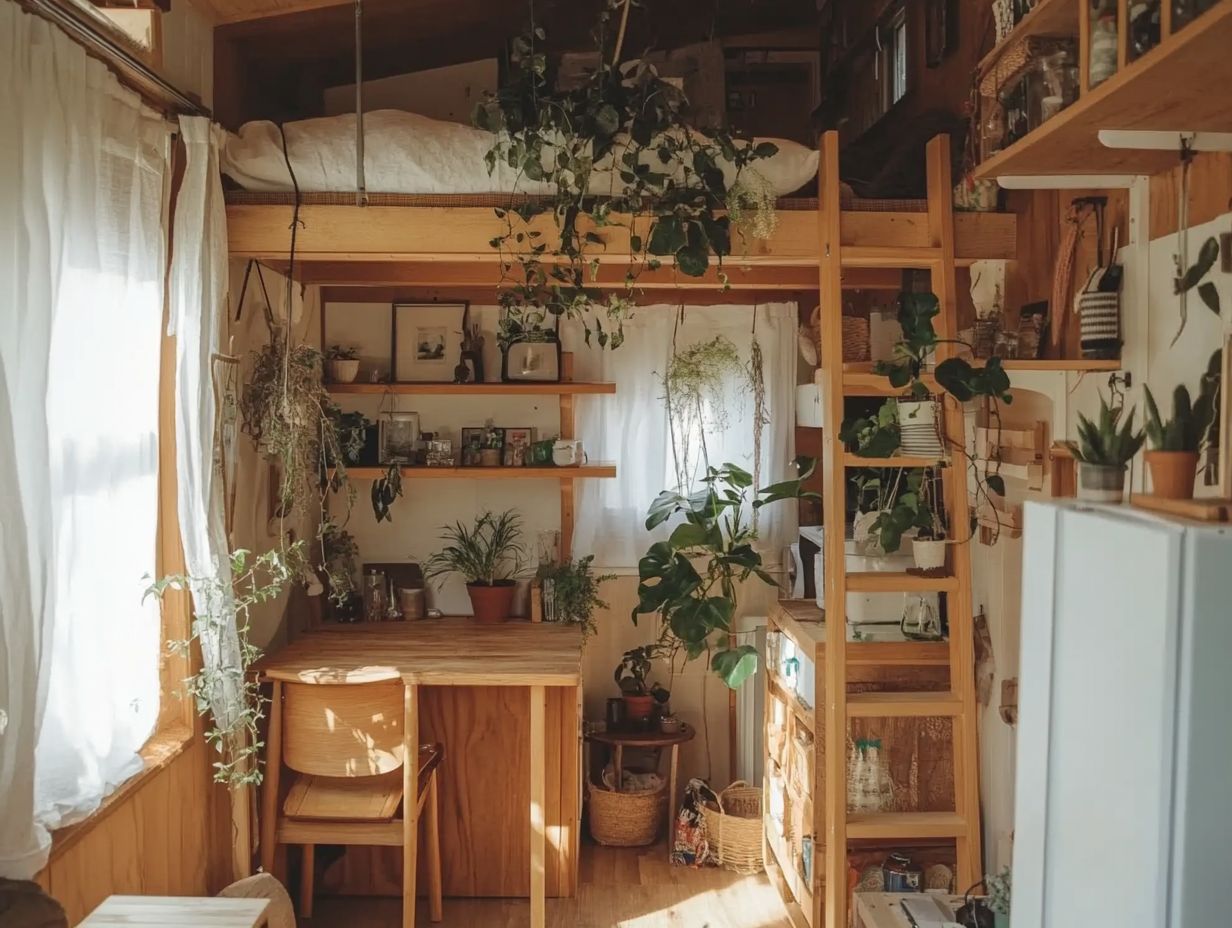
- Save space and add versatility to your tiny house by building a Murphy bed that can be easily stowed away when not in use.
- Create a sustainable and convenient herb garden by utilizing vertical space and repurposing reclaimed materials found in your tiny home.
- Save money and reduce your carbon footprint by installing a composting toilet in your tiny house instead of a traditional flush toilet.
1. Build Your Own Murphy Bed
Building your own Murphy bed in a tiny home is an excellent strategy to maximize your space while seamlessly blending functionality and style. It reflects the idea of simple living in compact spaces.
By incorporating reclaimed wood into your design, you not only add character but also champion sustainability. This eco-friendly choice reduces waste and minimizes your environmental footprint.
As you get creative with custom designs, think about versatility in your bed s function. Consider integrating shelving or a fold-out desk into the frame for added utility.
This DIY project isn t just a practical upgrade; it gives you the power to craft a personalized aesthetic that showcases your unique taste while optimizing every last inch of your cozy haven.
2. Create a Vertical Herb Garden
Creating a vertical herb garden in your tiny home not only saves precious space but also enhances your commitment to sustainability and access to fresh ingredients, perfectly aligning with the principles of tiny house living.
This innovative approach beautifies your living area and transforms it into a mini oasis of flavors and fragrances. By utilizing materials such as reclaimed wood, PVC piping, or vertical planters, you can design a functional yet aesthetically pleasing herb garden that reflects your style.
For those navigating limited space in small living spaces, this eco-friendly option is a practical way to cultivate fresh herbs like basil, mint, or parsley just a few steps away from your kitchen.
Regular maintenance is key; ensuring adequate sunlight, consistent watering, and occasional pruning will help your garden thrive. Integrating such green practices within your tiny home contributes significantly to a sustainable lifestyle.
3. Install a Composting Toilet
Installing a composting toilet in your tiny home is a brilliant way to embrace sustainable living. It significantly reduces water usage and waste while enhancing the eco-friendly charm of compact living.
This system minimizes your environmental footprint by transforming waste into nutrient-rich compost, all without the need for traditional plumbing. That means you save on both installation costs and ongoing maintenance.
The magic of a composting toilet lies in a natural process that helps break down waste, which employs natural materials like sawdust or peat moss.
Before diving in, it s wise to consult local zoning regulations and building codes, as these can vary widely. Ensuring compliance before installation is essential.
Beyond just sustainability, integrating this system into your tiny home boosts safety by eliminating risks associated with sewage backups and chemical treatments, making it a savvy choice for modern minimalist living.
Start your DIY journey today!
4. Make Your Own Solar Panels
Creating your own solar panels for your tiny home is not just a rewarding DIY project; it s a significant step toward enhancing energy efficiency and embracing sustainable living. By harnessing renewable energy, you have the opportunity to reduce your carbon footprint.
This endeavor gives you the power to take control of your energy consumption while deepening your understanding of renewable energy systems. To get started on building your solar panels, you’ll need essential materials like solar cells that convert sunlight into electricity, a backing board, and a junction box (a box that connects different wires safely), along with tools such as a soldering iron, wire cutters, and a multimeter.
By dedicating some time to this project, you can drastically cut your energy costs and contribute to a more sustainable lifestyle. It aligns beautifully with the tiny house movement, embodying the principles of simplicity, efficiency, and environmental responsibility making it a perfect addition to any small living space.
5. Construct a Loft for Extra Space
Constructing a loft in your tiny home is a brilliant way to maximize vertical space. It offers additional storage or living areas while elevating the overall design and functionality of compact living. This innovative approach infuses character into your space and fosters a sense of openness and flexibility.
To ensure your loft is both safe and structurally sound, it’s crucial to start with a solid framework, using high-quality materials that can support the weight of furniture and occupants. Proper reinforcement and secure railing systems will enhance safety and give you peace of mind.
As you design your loft, use minimalist principles to declutter and simplify. Opt for multifunctional furniture and creative storage solutions that harmonize with your home s aesthetic, ultimately crafting a cozy yet spacious environment.
6. Use Multipurpose Furniture
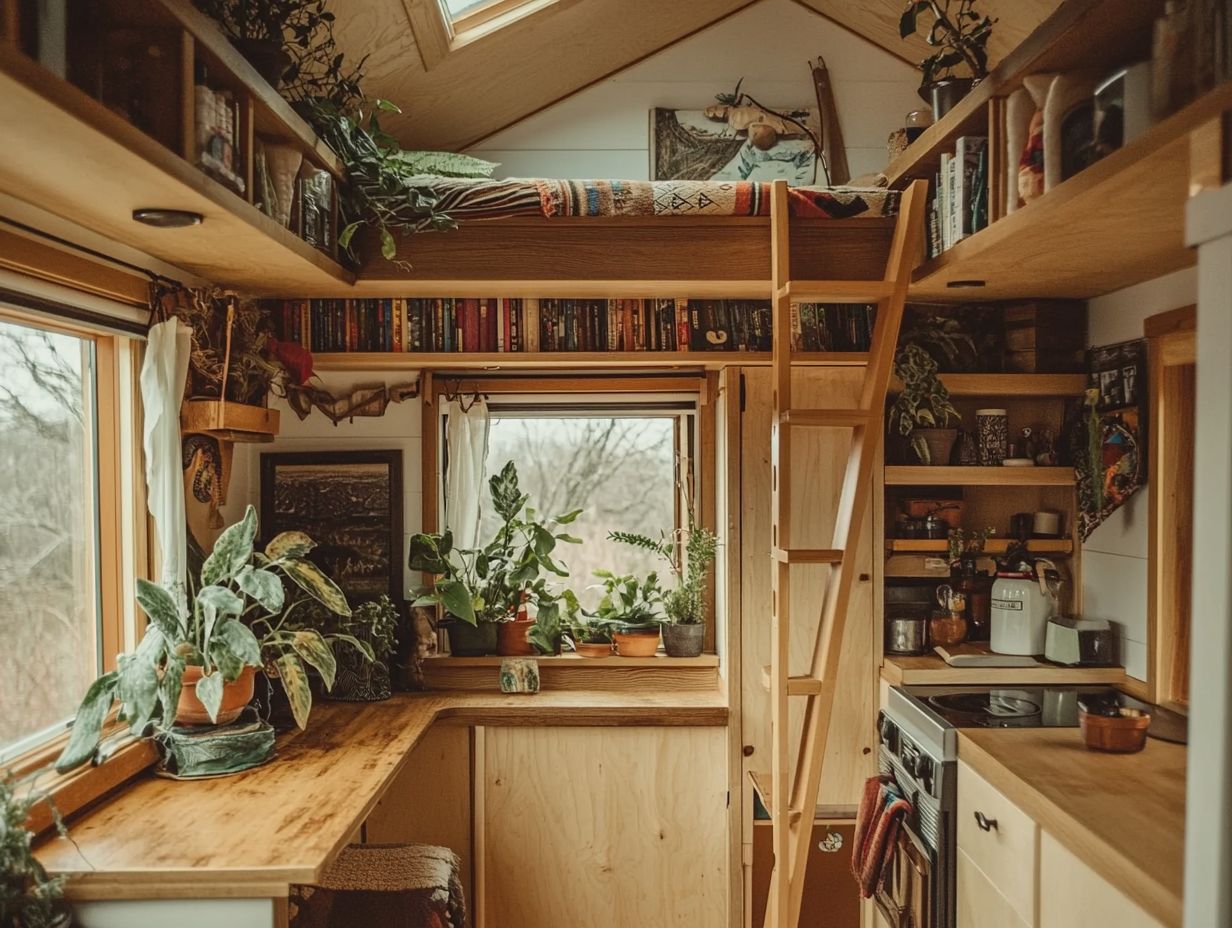
Using multipurpose furniture in your tiny home is key to space-efficient living. This furniture helps you maximize functionality while keeping your space stylish and comfortable.
Imagine integrating options like fold-out tables that transform into workspaces or sofas that convert into beds these features can dramatically enhance the usability of every square foot. Consider storage ottomans and shelving units that double as room dividers; they provide clever solutions for organizing your personal belongings while maintaining an open feel.
By selecting these innovative pieces, you can create a clutter-free environment tailored to your lifestyle. Not only do these furniture choices streamline your everyday tasks, but they also foster an inviting atmosphere, making tiny living both practical and aesthetically pleasing.
7. Install a Rainwater Collection System
Installing a rainwater collection system in your tiny home is a great way to live sustainably! It allows you to conserve water and make effective use of natural resources.
An effective rainwater collection system includes important parts such as a well-suited roof catchment area, gutters, a downspout, a storage tank, and a filtration system to keep the collected water clean and ready for use.
When properly set up, the process starts with directing rainwater from your roof into gutters that funnel it into a sturdy tank. This water can then be stored for later use in everything from gardening to washing or even flushing toilets. By embracing such a system, you enhance your self-sufficiency in water management and shrink your environmental footprint significantly.
By harnessing rainwater, you become an active participant in water conservation, contributing meaningfully to sustainable living initiatives while enjoying the added perk of lower utility costs. How much could you save on water bills?
8. Build a Tiny House on Wheels
Building a tiny house on wheels gives you flexibility and mobility. It allows you to embrace the tiny house movement while following the rules about building and enjoying the benefits of compact living.
This innovative approach encourages a minimalist lifestyle and invites you to downsize your possessions and live more sustainably. However, it also brings unique challenges, like crafting a solid foundation that is both durable and compliant with local regulations.
Navigating the requirements of RV parks can add another layer of complexity, as many impose specific rules regarding occupancy and house specifications.
While the allure of tiny living on wheels is certainly enticing, it’s essential to give thoughtful consideration to ensure you enjoy a comfortable and compliant living experience.
9. Create a Fold-Down Table
A fold-down table is a smart way to make better use of space. It ensures you have a dining area in your tiny home, making it a perfect choice for small space living environments.
This innovative piece not only provides a place for meals but also doubles as a workspace or an extra surface for crafts and projects in your compact living space.
When considering how to construct such a table, think about using lightweight materials that are easy to mount and can support various activities. Incorporating design elements like wood stains or paint that complement your existing decor will elevate the overall aesthetic.
Beyond functionality, this versatile furniture allows for seamless transitions, enabling you to reclaim your space when the table is not in use. It s an effortless way to blend practicality with style perfect for those embracing tiny living tips!
10. Utilize Under Stair Storage
Under-stair storage turns unused space into clever storage solutions. You can transform this often-overlooked area into a canvas for ingenious storage options, creating hideaways that blend seamlessly with your decor.
Imagine incorporating built-in shelves or perhaps a cozy reading nook complete with cushions and bookshelves! Not only does this optimization enhance the functionality of the space, but it also adds a touch of character.
For those who revel in DIY projects for tiny homes, crafting custom cabinets or stylish drawers can yield results that are both highly functional and visually appealing. These approaches declutter your living environment and infuse a unique charm that reflects your personal taste. To enhance your tiny space further, consider exploring the top 10 tiny house interior design hacks. Even the smallest spaces can be stylish and purposeful, proving that creativity knows no bounds.
What Are the Benefits of DIY Projects for Tiny Houses?
Doing DIY projects for tiny houses has many benefits. You save money and can create designs that truly reflect your style! This journey gives you the power to create a space that genuinely reflects your values.
By taking on these projects yourself, you can dramatically cut down on labor costs, potentially saving thousands that would otherwise go to hiring professionals. This newfound financial flexibility allows you to explore innovative design solutions, from crafting custom tiny furniture with reclaimed materials to installing solar panels that enhance energy efficiency.
Engaging in DIY efforts harmonizes beautifully with the tiny house movement‘s ethos, which champions innovation and sustainability. For example, transforming a shipping container into a cozy living space not only showcases your creativity but also minimizes waste, embodying a resourceful approach to living light and purposefully. To explore more about eco-friendly options, check out the top 10 sustainable building techniques for tiny houses.
What Are Some Essential Tools for DIY Tiny House Projects?
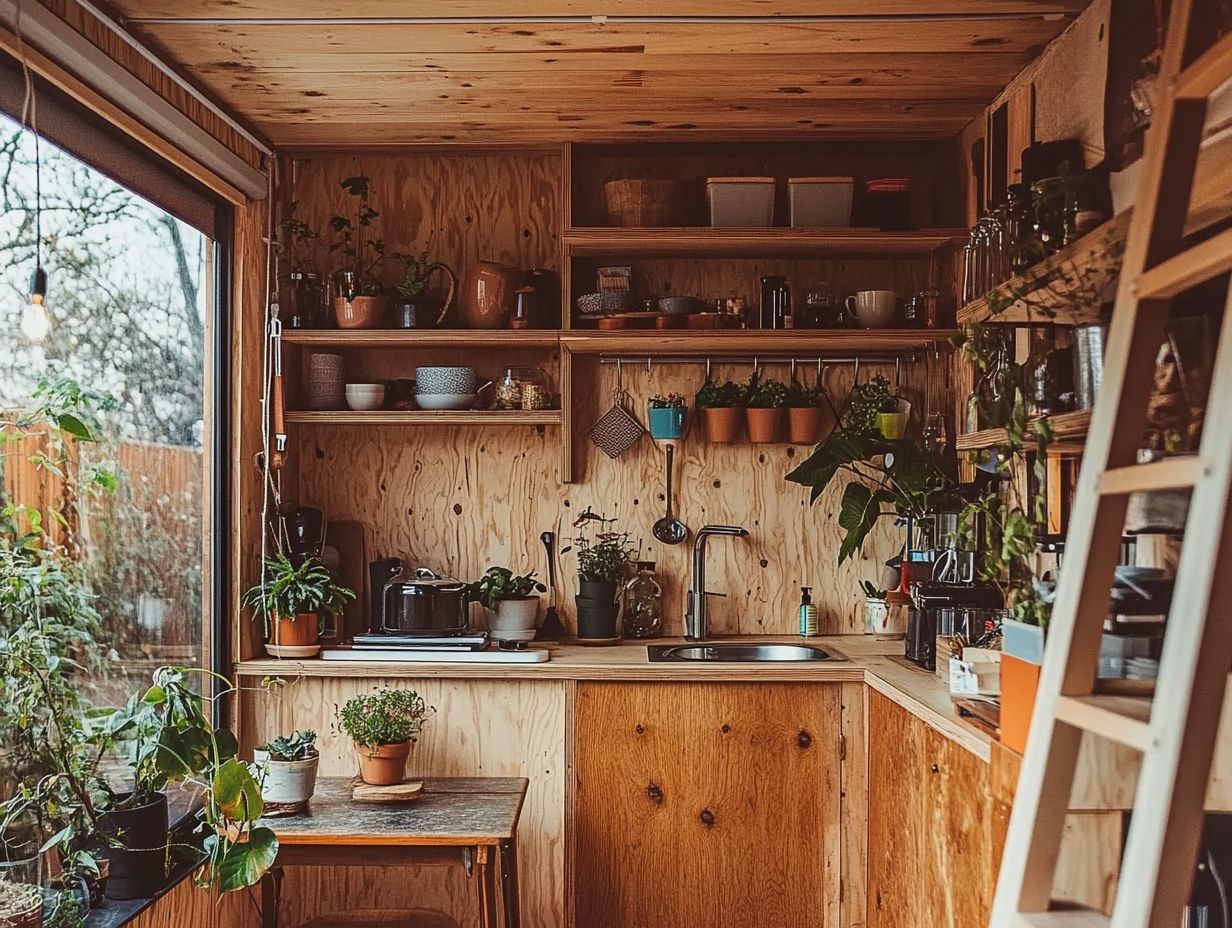
Get ready to transform your tiny house with the right tools! Having the right set of tools is essential for anyone diving into DIY tiny house projects. They can significantly enhance your efficiency and the quality of your home construction, ultimately leading to impressive results.
In the world of tiny home construction, a well-equipped toolkit isn’t just a luxury it’s a necessity. It gives you the power to tackle a variety of tasks, from framing to those all-important finishing touches in your tiny home designs. Essential tools like a level, circular saw, and a reliable drill give you the precision you need, ensuring every joint and angle is just right. These tools also promote sustainable practices, allowing you to use reclaimed materials (wood and other materials that have been salvaged for reuse) and minimize waste.
By investing in the correct equipment, homeownership becomes more attainable for you, letting you turn your dreams into reality and create eco-friendly homes that truly reflect your vision.
How Can DIY Projects Help Save Money in a Tiny House?
Start your DIY projects today and watch your savings grow! Engaging in DIY projects within tiny homes can yield significant cost savings, giving you the power to allocate your budget more effectively while still achieving your desired design and functionality.
For example, when you construct custom shelves from reclaimed wood, you not only infuse your space with unique charm but also save money compared to purchasing pre-made options. Another popular project involves crafting kitchen cabinets from plywood, which can be easily stained or painted to align perfectly with your aesthetic vision.
Beyond the financial benefits, these DIY pursuits allow you to express your personal style and customize your living space to meet your specific needs. By opting for sustainable materials and taking on projects like building your own furniture or landscaping with drought-resistant plants, you can further reduce your environmental footprint while enjoying the satisfaction that comes from hands-on craftsmanship.
What Are Some Common Mistakes to Avoid in DIY Tiny House Projects?
Avoiding common mistakes in your DIY tiny house projects is essential for ensuring that the construction is efficient and meets necessary building codes, ultimately leading to a successful build.
To achieve this, familiarize yourself with the potential pitfalls of building codes that can arise throughout the process. Whether it s neglecting to measure materials accurately or overlooking essential structural elements, these oversights can compromise not just the aesthetics but also the safety of your project.
For instance, taking the time to double-check measurements can significantly enhance the integrity of the framework. By incorporating best practices like using high-quality materials and dedicating ample time to each phase you can greatly reduce the risk of costly revisions later on.
Ultimately, a keen focus on detail will ensure that your tiny house is safe, sturdy, and built to stand the test of time.
What Are Some Creative Ways to Maximize Space in a Tiny House?
Maximizing space in a tiny house calls for innovative thinking and creative solutions, allowing you to craft a functional living area that feels both open and comfortable, no matter how compact it may be.
To achieve this, consider incorporating multipurpose furniture, like a sofa bed or a coffee table with built-in storage. These pieces can dramatically enhance versatility in your space.
Utilizing vertical space for shelving and hooks can also free up valuable floor area while keeping your essentials organized and easily accessible.
Think about creative layouts, such as sliding partitions or foldable walls. These can transform a single room into dual-purpose areas, enabling you to transition effortlessly between relaxation and work.
By embracing these strategies, you can truly maximize every inch of your tiny home, fostering a more enjoyable and efficient living sustainably.
How Can DIY Projects Make a Tiny House More Sustainable?
Engaging in DIY projects can truly elevate the sustainability of your tiny house, allowing you to incorporate eco-friendly options and utilize reclaimed materials that contribute to a smaller carbon footprint.
These projects not only make your home unique but also deepen your bond with nature! For example, using salvaged wood for furniture or fixtures reduces waste and infuses your space with unique character.
Collecting rainwater for later use can seamlessly integrate into your tiny home design, helping you conserve precious resources. Choosing non-toxic paints and finishes ensures that your indoor air quality remains top-notch, ultimately benefiting your health and supporting sustainable living.
By embracing these sustainable practices, you can creatively customize your living space while playing a crucial role in preserving the planet for future generations.
Frequently Asked Questions
What are the top 10 DIY projects for tiny house enthusiasts?
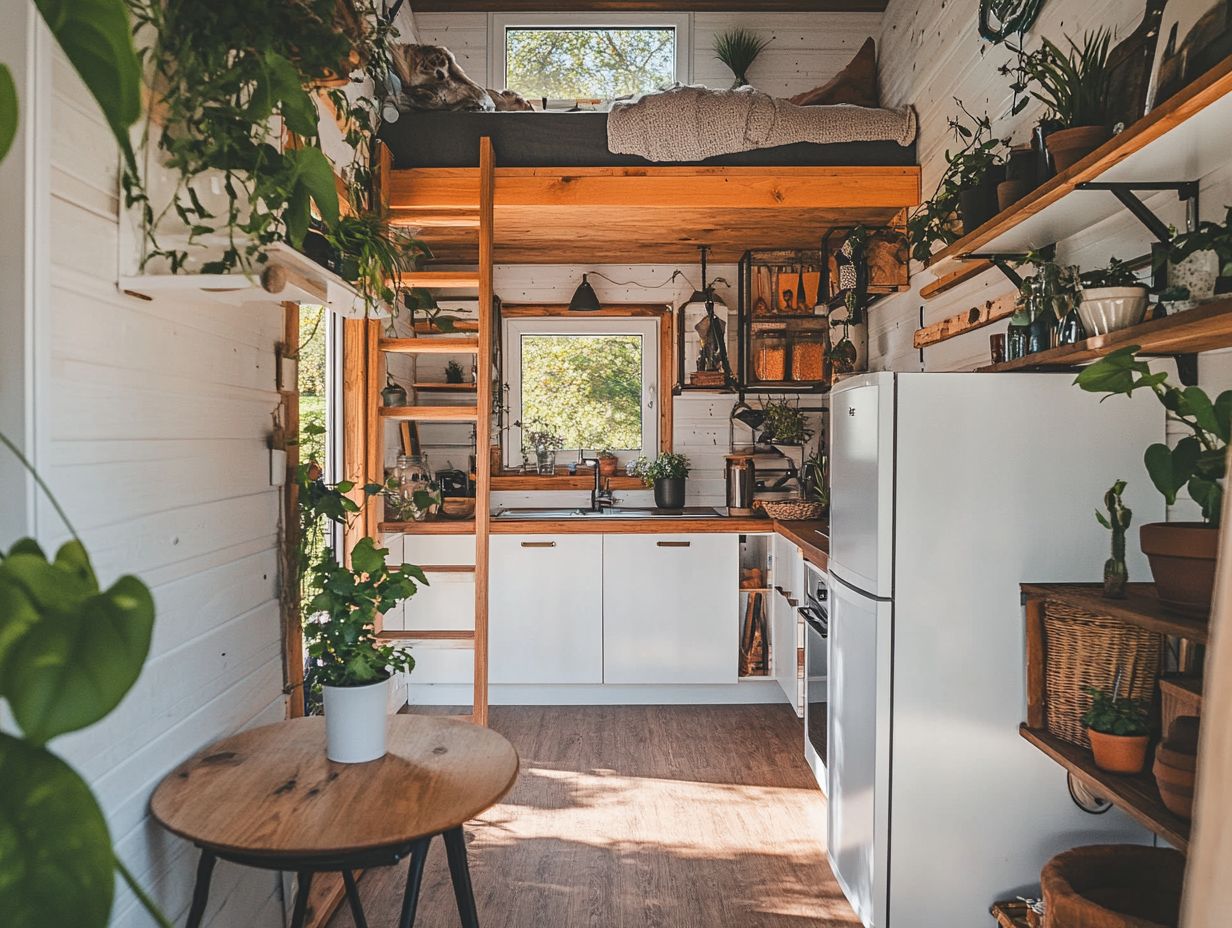
- Build a custom loft bed to maximize space.
- Create a mobile kitchen island for added functionality.
- Install a rainwater catchment system to conserve water and reduce utility costs.
- Construct a fold-down dining table for versatile dining options.
- Build a composting toilet, a toilet that uses composting instead of water.
- Install a solar panel system to generate renewable energy.
- Create a living wall or vertical garden to add greenery.
- Build a pull-out pantry for efficient food storage.
- Install a Murphy bed for a comfortable sleep space that can be tucked away.
- Construct a DIY home security system using smart technology for added protection.
Why are these DIY projects beneficial for tiny house enthusiasts?
These projects allow tiny house enthusiasts to customize their space to fit their individual needs and preferences while maximizing the limited space available. Many of these projects can also save you money and promote sustainability.
Do I need to be an experienced builder to complete these projects?
Absolutely! Many projects are beginner-friendly and require just basic tools. Dive in, and you ll learn as you go!
Can I incorporate these projects into an already built tiny house?
Yes, many of these projects can be added to an existing tiny house to improve its functionality and efficiency. However, some projects may require more extensive renovations and should be carefully planned out before beginning.
Are these projects cost-effective?
Yes, most of these budget-friendly DIY projects utilize affordable materials. The long-term cost savings from projects like a solar panel system or rainwater catchment system can make them wise investments in the long run.
How can I find more information about these projects?
There are many online resources, such as blogs, forums, and YouTube tutorials, that provide step-by-step instructions for completing these DIY projects related to tiny home designs. You can also consult with other tiny house enthusiasts or seek professional advice for guidance.
Ready to start your DIY journey? Gather your tools and let s get building!

